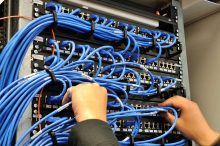Structured Cabling
Structured Cabling is a necessary infrastructure for places that want to maintain stable networks, both in businesses and homes. The project carries out the standardization of connectors and transmission media.
If You are living in Southern California Contact STARLIGHT to discuss your needs, We would be happy to propose a solution
- Email: info@starlightcabling.com
- Phone: 949-434-4252
With the growing need to use technological communication equipment, it is essential to prepare a structure that supports the regular use of laptops, tablets, servers, and other devices connected to the internal network.
Planning for Structured Cabling is essential, avoiding any unforeseen event that generates problems for the internet network. Count on a company experienced in the subject, to supply the best materials, and carry out the proper implementation and the necessary tests to reduce the risks of failures.
Benefits of Structured Cabling:
Carrying out the entire implementation of Structured Cabling is very important, especially in companies, as it brings organization and practicality for when there is a need to install new equipment or replace some of them.
Without Structured Cabling, it will be difficult not to have clutter in a future addition of equipment.
This can harm the information traffic, leaving the network slow and with noise that is difficult to identify.
The Structured Cabling project also offers a number of benefits such as:
- Fast and simple maintenance;
- Easy installation of new connections;
- Reduced cost in the medium and long term;
- Easy error identification;
- Integration of several applications in single cabling;
- Allows longer life for the cabling system;
- Maximum utilization of network capacity.
Structured Cabling Types:
Twisted Pair Cable
Twisted-pair cable is widely used for building local area networks. It gets its name from its composition, as it consists of four pairs of cables intertwined with each other. The advantage of a twisted pair cable is the reduction of electromagnetic interference.
There are different types of cabling categories. The essential difference between one category and another is the speed of data transfer. For example, category 5e can transfer up to 1 Gbps (gigabits of data per second), while 6 Gbps is designed to share huge amounts of data, transmitting from 1 Gbps to 10 Gbps.
In addition to these, there are other types of twisted-pair cables, such as category 5, which is already out of the market, or category 6a, which transmits data from 10 Gbps.
Fibre Optic Cable
One of the applications of optical fibre is for data transmission. This type of fibre is characterized by flexible filaments constructed of transparent materials such as plastic or glass fibres.
They are used as a means of propagating light. Optical fibres are generally very thin, only a few micrometres thick (10-6 m) and can be several kilometres long.
If You are living in Southern California Contact STARLIGHT to discuss your needs, We would be happy to propose a solution
- Email: info@starlightcabling.com
- Phone: 949-434-4252
